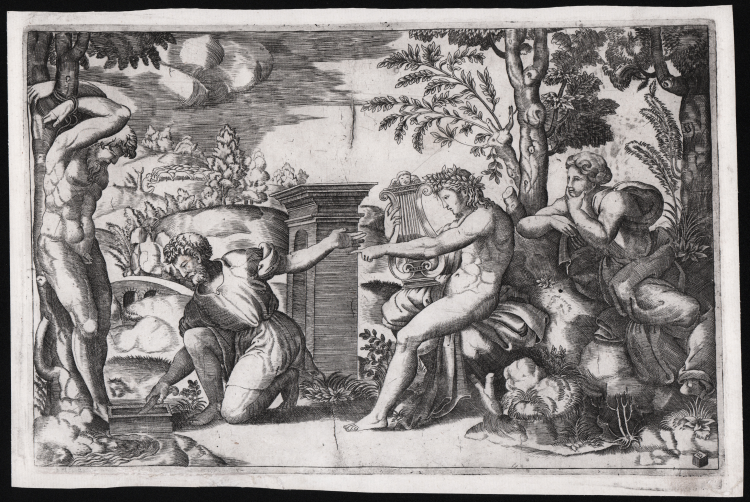





| Reference: | S48426 |
| Author | Maestro B nel Dado |
| Year: | 1530 ca. |
| Measures: | 290 x 190 mm |




| Reference: | S48426 |
| Author | Maestro B nel Dado |
| Year: | 1530 ca. |
| Measures: | 290 x 190 mm |
Seated nude Apollo at right with a lyre on his right knee, indicating to a kneeling man to take a knife from a box to flay Marsyas who is tied naked to a tree at left
Engraving, c. 1530, signed in plate lower right with B symbol in die. From a lost Raphael subject in the Loggetta, possibly executed by his circle.
This engraving replicates quite faithfully, another of the same subject also signed by the Master of the Die. Although one is a copy of the other, it can be assumed that both are executed by the artist.
Specimen in the first state of two, forward of Pietro de Nobili's address.
Magnificent proof, printed on contemporary laid paper with watermark “eagle in circle with crown” (Woodward nos. 55-58), with small margins, in excellent condition.
“Il soggetto, in relazione con l'analogo tema della volta della Segnatura come suggerisce la figura di Marsia la cui posizione corrisponde all'affresco relativo - eccetto che per le mani diversamente intrecciate - è ispirato ad un dipinto della Loggetta Bibbiena del 1519. Infatti, il supplizio di Marsia sarebbe tratto da una scena dispersa dipinta su fondo nero, accanto ad Apollo nella Loggetta ideata da Raffaello e realizzata in affresco, sotto la sua direzione, da Giulio Romano, Gian Francesco Penni, Perin del Vaga e Giovanni da Udine. È pertanto probabile che l'incisione sia stata eseguita intorno al 1532, anno che appare nella incisione dello stesso maestro con la Venere punta da una spina (Bartsch, XV. 16; Massari, 1985, p. 63, VII.5) chiaramente ispirata al soggetto analogo dipinto nella Stufetta Bibbiena. Il mito di Apollo e Marsia che si legge nelle Metamorfosi di Ovidio - (VI, 382-400) era celebre tra gli artisti del Rinascimento che lo interpretavano come una vera e propria allegoria in cui veniva celebrata la vittoria dell'armonia superiore e dell'ordine simboleggiato da Apollo. Questi, irritato per l'abilità di Marsia nel suonare, lo aveva sfidato in una gara musicale (flauto, canto, cetra) e, vinta la disputa con l'appoggio delle Muse, aveva inflitto a Marsia la crudele punizione. La posizione di Marsia appeso all'albero mentre viene scorticato è chiaramente ispirata alla statua di epoca romana copia dell'originale greco del terzo sec. a.C., ora agli Uffizi. La statua di "Marsia legato con le braccia alte ad una colonna", assai popolare nella cerchia raffaellesca, si trovava nel 1520 ca. nel cortile del Cardinale Andrea della Valle, come testimoniato dal disegno dell'Heemskerck del 1530 e dall'incisione di Hieronymus Cock. Successivamente l'opera era passata nel 1584, insieme ad altre sculture, nella collezione di Villa Medici. Il minuzioso e preciso bulino del maestro del Dado traccia sulla matrice un andamento di linee prevalentemente rettilinee o comunque regolari, il risultato è che l'immagine appare particolarmente equilibrata, pur molto concedendo al decorativismo dei particolari” (cfr. S. Massari, Tra Mito e Allegoria, p. 96).
Bibliografia
Bartsch, Le Peintre graveur (XV.206.31); cf. S. Massari, Tra Mito e Allegoria, pp. 96-97, n. 29.
Maestro B nel Dado (Attivo a Roma, metà XVI sec.)
|
Master del Dado was trained as painter and engraver in Marcantonio’s workshop; he was born around 1512 and worked in Rome between 1532 and 1550. He is very often mistaken with Beatricetto or Bonasone.
Le Blanc believes that he was a descendant of Bernardo Daddi (1512 – Rome 1570), a painter, according to the monogram that signs his prints. Some others identify him with Benedetto Verini, presumed son of Marcantonio, which would have explained the monogram BV on his plates. According to Bartsch though, the V might stand for Venetian or again for Tommaso Vincidor da Bologna.
He engraved drawings of other artists for Lafrery; his favourite subjects were Raphael, Peruzzi, Giulio Romano and Tommaso Vincidor.
To Master del Dado have been ascribed about 85 prints, according to Malaspina and also Bartsch says they are 85, while Passavant believes they are 89.
|
Maestro B nel Dado (Attivo a Roma, metà XVI sec.)
|
Master del Dado was trained as painter and engraver in Marcantonio’s workshop; he was born around 1512 and worked in Rome between 1532 and 1550. He is very often mistaken with Beatricetto or Bonasone.
Le Blanc believes that he was a descendant of Bernardo Daddi (1512 – Rome 1570), a painter, according to the monogram that signs his prints. Some others identify him with Benedetto Verini, presumed son of Marcantonio, which would have explained the monogram BV on his plates. According to Bartsch though, the V might stand for Venetian or again for Tommaso Vincidor da Bologna.
He engraved drawings of other artists for Lafrery; his favourite subjects were Raphael, Peruzzi, Giulio Romano and Tommaso Vincidor.
To Master del Dado have been ascribed about 85 prints, according to Malaspina and also Bartsch says they are 85, while Passavant believes they are 89.
|